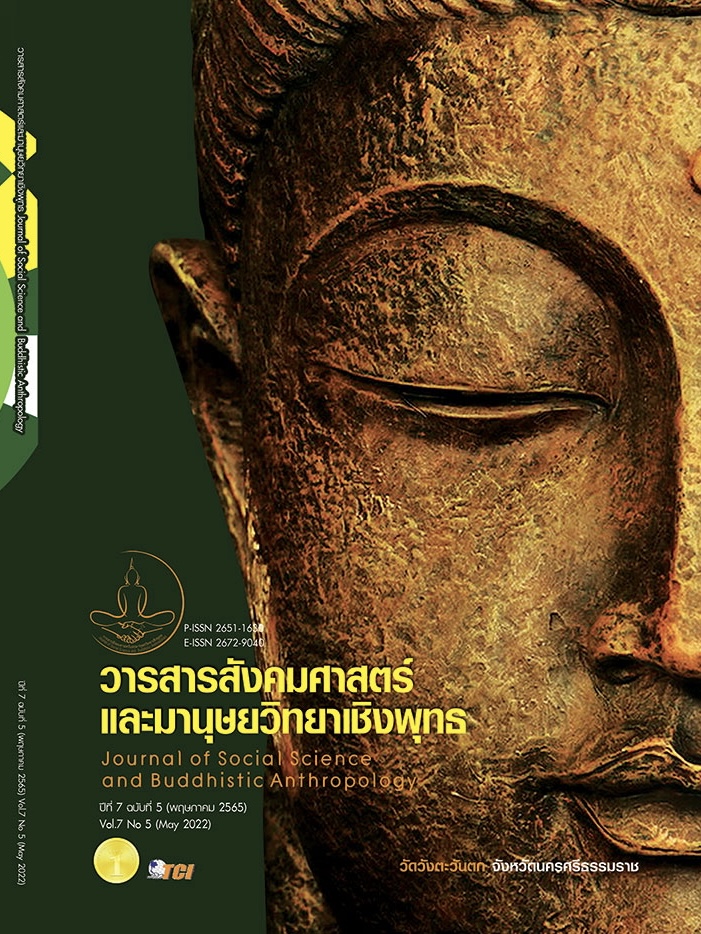THE DEVELOPMENT OF LEARNING MANAGEMENT MODEL AND INSTRUMENTS FOR PROMOTING ADVERSITY QUOTIENT IN THE CONTEXT OF THE DIGITAL AGE BY USING THE CONCEPT OF CONNECTIVISM FOR UNDERGRADUATE STUDENTS WITH DIFFERENT PERSONALITIES
Keywords:
Learning Management Model, Lesson Plan, Adversity Quotient, ConnectivismAbstract
The objectives of this research article were to 1) synthesize elements of a learning management model that promotes adversity quotient in the context of the digital age by using the concept of connectivism for undergraduate students with different personalities. 2) develop a lesson plan and instruments for promote adversity quotient in the context of the digital age using the concept of connectivism for undergraduate students with different personalities. The statistics used to determine the quality of the research model and tools consisted of mean, standard deviation and IOC. The results showed that the systematic approach to learning management consists of 3 main components: 1) basic elements that promote adversity quotient; 2) the component of the learning management process and 3) the component of the ability of adversity quotient. Assessing the suitability of the model by experts in educational technology curriculum and instruction, and psychology, 7 persons had the overall average at the most appropriate level ( = 4.52, S.D. = 0.62) and the assessment of the instruments by experts in educational technology, psychology, curriculum and instruction, measurement and evaluation: 5 persons assessed the structural conformity of the lesson plan with the value between 0.8 - 1.0. The questionnaire for adversity quotient in the context of the digital age had the content accuracy between 0.6 - 1.0. Personality test has a content validity between 0.6 - 1.0. The behavioral observation form has an overall average at the most appropriate level (
= 3.80, S.D. = 0.45). The performance assessment form had the overall average at the most appropriate level (
= 4.00). Reflective learning log had the overall average at the most appropriate level (
= 3.70, S.D. = 0.60).
References
กนกวรรณ จิตต์งามขำ. (2558). ผลของโปรแกรมพละ 5 เพื่อพัฒนาความสามารถในการเผชิญและฟันฝ่าอุปสรรคของนักศึกษา ชั้นปีที่ 1 ภาควิชาครุศาสตร์ไฟฟ้า. ใน วิทยานิพนธ์ศึกษาศาสตร์มหาบัณฑิต สาขาวิชาจิตวิทยาการศึกษาและการแนะแนว. มหาวิทยาลัยเทคโนโลยีพระจอมเกล้าพระนครเหนือ.
กระทรวงดิจิทัลเพื่อเศรษฐกิจและสังคม. (2559). แผนพัฒนาดิจิทัลเพื่อเศรษฐกิจและสังคม. เรียกใช้เมื่อ 4 สิงหาคม 2563 จาก http://www.mdes.go.th/assets/portals/1/files/590613_4Digital_Economy_Plan-Book.pdf
ใจทิพย์ ณ สงขลา. (2561). การออกแบบการเรียนแนวดิจิทัล. (พิมพ์ครั้งที่ 1). กรุงเทพมหานคร: ภาควิชาเทคโนโลยีและสื่อสารการศึกษา คณะครุศาสตร์ จุฬาลงกรณ์มหาวิทยาลัย.
บุญจันทร์ สีสันต์. (2557). การวิเคราะห์องค์ประกอบคุณลักษณะผู้นำแบบรับใช้ของครูสังกัดสำนักงานคณะกรรมการการอาชีวะศึกษา กระทรวงศึกษาธิการ. วารสารครุศาสตร์อุตสาหกรรม, 13(2), 58-65.
บุญชม ศรีสะอาด. (2546). การพัฒนาหลักสูตรและการวิจัยเกี่ยวกับหลักสูตร. (พิมพ์ครั้งที่1). กรุงเทพมหานคร: สุวีริยาสาส์น.
. (2547). วิธีการทางสถิติสำหรับการวิจัย. (พิมพ์ครั้งที่ 4). กรุงเทพมหานคร: สุวีริยาสาสน์.
บุญเชิด ภิญโญอนันตพงษ์. (2527). การทดสอบแบบอิงเกณฑ์:แนวคิดและวิธีการ. กรุงเทพมหานคร: โอเดียนสโตร์.
ภัทรา วยาจุต. (2550). ผลของการเรียนแบบผสมผสานและแบบใช้เว็บช่วยที่มีต่อผลสัมฤทธิ์ทางการเรียนของนิสิตระดับปริญญาบัณฑิต จุฬาลงกรณ์มหาวิทยาลัยที่มีบุคลิกภาพต่างกัน. ใน วิทยานิพนธ์ครุศาสตรมหาบัณฑิต สาขาวิชาโสตทัศนศึกษา. จุฬาลงกรณ์มหาวิทยาลัย.
รัตนากร กิจขันธ์. (2552). ความสัมพันธ์ระหว่างบุคลิกภาพห้าองค์ประกอบการรับรู้ความสามารถของตนเองและความสามารถในการเผชิญปัญหาและฟันฝ่าอุปสรรค กรณีศึกษาพนักงานบริษัทรถยนต์แห่งหนึ่ง. ใน วิทยานิพนธ์ศิลปศาสตรมหาบัณฑิต สาขาวิชาจิตวิทยาอุตสาหกรรมและองค์การ. มหาวิทยาลัยธรรมศาสตร์.
วารนันท์ นิติศักดิ์. (2557). การพัฒนารูปแบบการเรียนการสอนผ่านเครือข่ายอินเทอร์เน็ตตามทฤษฎีคอนเนคติวิสต์ซึมของนักศึกษาโครงการมหาวิทยาลัยชีวิต มหาวิทยาลัยราชภัฏชัยภูมิ. ใน ดุษฎีนิพนธ์ศึกษาศาสตรดุษฎีบัณฑิต สาขาวิชาเทคโนโลยีการศึกษา. มหาวิทยาลัยเกษตรศาสตร์.
สนิท สิทธิ. (2557). รูปแบบการสอนผ่านเว็บตามทฤษฎีการเรียนรู้คอนเน็คติวิซึมเพื่อสร้างเสริมทักษะการแก้ปัญหาด้านเทคโนโลยีสารสนเทศและการสื่อสารสำหรับนักศึกษาระดับอุดมศึกษา. ใน ดุษฎีนิพนธ์ศึกษาศาสตรดุษฎีบัณฑิต สาขาวิชาเทคโนโลยีการศึกษา. มหาวิทยาลัยเกษตรศาสตร์.
สุทธวิชญ์ แสงดาษดา. (2557). ดิจิทัลเปลี่ยนโลก. กรุงเทพมหานคร: โพสต์บุ๊กส์.
สุเมษย์ หนกหลัง. (2557). การพัฒนาความสามารถในการเผชิญการฟันฝ่าอุปสรรคของนักศึกษาครูโดยใช้โปรแกรมนันทนาการแบบมีส่วนร่วมในกระบวนการเรียนรู้แบบชี้นำตนเอง. ใน ดุษฎีนิพนธ์ปรัชญาดุษฎีบัณฑิต สาขาวิชาการพัฒนาทรัพยากรมนุษย์และชุมชน. มหาวิทยาลัยเกษตรศาสตร์.
โสระยา พยัคฆ์ฤทธิ. (2559). ผลของการใช้โปรแกรมเสริมสร้างความสามารถในการเผชิญอุปสรรคในการเรียนของนักเรียนชั้นมัธยมศึกษาปีที่ 4 โรงเรียนแจงร้อนวิทยา กรุงเทพมหานคร. ใน วิทยานิพนธ์การศึกษามหาบัณฑิต สาขาวิชาการวิจัยและพัฒนาศักยภาพมนุษย์. มหาวิทยาลัยศรีนครินทรวิโรฒ.
อภิชาติ จริยาวิลาศ. (2562). 5 ข้อน่าห่วงเด็กไทย ยุค 4.0. เรียกใช้เมื่อ 18 มิถุนายน 2563 จาก https://www.springnews.co.th/thailand/417385
Amal, J. K. & Hokyoung, R. (2013). Am I Extravert or Introvert? Considering the Personality Effect Toward e-Learning System. Journal of Educational Technology & Society, 16(3), 14-27.
Downes, S. (2006). Learning networks and connective knowledge. Collective intelligence and elearning, 20(1), 1-26.
Hargitta, E. (2007). Whose space? Differences among users and non-users of social network sites. Journal of Computer-Mediated Communication, 13(1), 276-297.
Jonassen, D. H. (2011). Learning to Solve Problems A Handbook for Designing Problem-Solving Learning Environment. New York: Routledge.
Jung, C. G. (1959). Psychology Types. London: Routledge’s Kegan Paul Board Way House.
Kemp, S. (2019). Digital 2019: global internet use accelerates. Retrieved August 4, 2020, from https://wearesocial.com/blog/2019/01/digital-2019-global-internet-use-accelerates
Shepherd, J. (2004). Why the Digital Era? Retrieved August 4, 2020, from https://www.igi-global.com/viewtitlesample.aspx?id=29024&ptid=905&t= what+is+the+digital+era%3f
Siemens, G. (2004). Connectivism: A Learning Theory for the Digital Age. Retrieved August 4, 2020, from http://www.connectivism.ca
. (2005). Connectivism: A learning theory for a digital age. International Journal of Instructional Technology and Distance Learning, 2(1), 3-10.
Stoltz, P. G. (1997). Adversity Quotient Turning Obstacles into Opportunities. United State of America: John Wiley & Sons.
. (2000). Adversity Quotient @ work: make everyday challenges the key to your success-putting the principles of AQ into action. New York: Harper Collins Publishers Inc.
Taryn, O. (2017). Using E-Learning to Engage Introverts. Retrieved August 4, 2020, from https://trainingindustry.com/articles/e-learning/using-e-learning-to-engage-introverts/
Downloads
Published
How to Cite
Issue
Section
License
Copyright (c) 2022 Journal of Social Science and Buddhistic Anthropology

This work is licensed under a Creative Commons Attribution-NonCommercial-NoDerivatives 4.0 International License.








